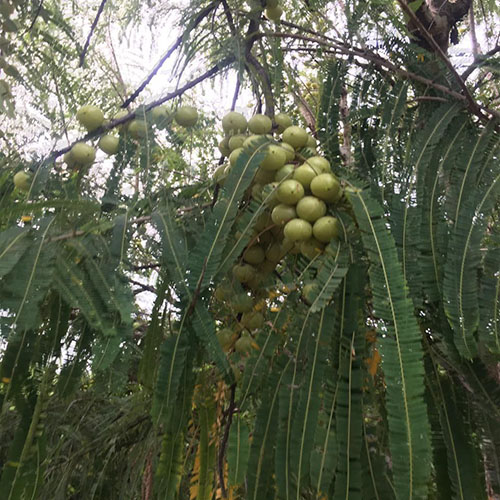N -7 Amla Plants
The N-7 Amla plant is a specific cultivar of the Indian gooseberry (Phyllanthus emblica), known for its high-quality fruits, productivity, and suitability for various climatic conditions. This variety is popular among growers for its consistent yield and the quality of its fruits, which are commonly used in Ayurvedic medicine, dietary supplements, and food products like pickles and juices.
Key Characteristics of N-7 Amla Plants
-
Fruit Size and Appearance:
- The N-7 Amla produces medium to large-sized fruits that are round and have a smooth, light green to yellow-green skin.
- The fruits are typically more uniform in size compared to other varieties, making them ideal for commercial production.
-
Flavor and Nutritional Value:
- N-7 Amla fruits have a typical astringent and sour taste, with high vitamin C content, antioxidants, and various other nutrients.
- The variety is often preferred for its balanced flavor profile, making it suitable for both direct consumption and processing into various products.
-
Tree Size and Growth Habits:
- The N-7 Amla tree is medium-sized, growing to a height of about 8 to 12 meters (26 to 39 feet).
- It has a spreading canopy and is known for its robust growth, with dense foliage that provides good shade.
-
Flowers and Fruiting:
- The tree produces small, greenish-yellow flowers that bloom in clusters, usually in the spring.
- The fruits typically mature and are ready for harvest around 6 to 8 months after flowering, usually in the autumn.
Growing N-7 Amla Plants
-
Climate Requirements:
- N-7 Amla plants thrive in subtropical and tropical climates. They are hardy and can withstand a wide range of temperatures from 0°C to 45°C (32°F to 113°F).
- The trees prefer areas with distinct dry and wet seasons, which help in synchronizing the flowering and fruiting cycles.
-
Soil Preferences:
- The N-7 variety grows best in well-drained loamy or sandy soils with a pH range of 6 to 8. It can tolerate slightly alkaline conditions and poor soils but performs best in fertile conditions with good organic content.
- Good drainage is essential to prevent root rot, especially in areas with heavy rainfall.
-
Sunlight:
- Full sunlight is crucial for the healthy growth and fruiting of N-7 Amla trees. Ensure the plants receive at least 6-8 hours of direct sunlight each day for optimal growth.
-
Watering:
- Young N-7 Amla plants need regular watering to establish strong roots. However, mature trees are relatively drought-tolerant and require less frequent watering.
- Watering should be adjusted according to the soil type and climate, avoiding waterlogging, which can damage roots and reduce fruit quality.
-
Fertilization:
- Apply organic compost or well-rotted manure at planting time and annually as a top dressing to maintain soil fertility.
- A balanced fertilizer containing nitrogen, phosphorus, and potassium can be applied twice a year, especially before the flowering stage and after harvesting, to support healthy growth and fruit production.
-
Pruning and Maintenance:
- Regular pruning is essential to maintain the shape of the N-7 Amla tree, remove dead or diseased branches, and promote better air circulation and sunlight penetration.
- Pruning also helps in managing the height of the tree, making it easier to harvest and reducing the risk of branches breaking under the weight of the fruits.
-
Pest and Disease Management:
- N-7 Amla is generally resistant to many pests and diseases, but it can still be affected by common issues like aphids, caterpillars, and fruit flies.
- Implement integrated pest management (IPM) strategies, including regular monitoring, using organic pesticides like neem oil, and encouraging natural predators to control pest populations.
- Ensure good air circulation and avoid overwatering to prevent fungal diseases such as powdery mildew and root rot.
Propagation
- Grafting and Budding: N-7 Amla is usually propagated through grafting or budding to ensure that the new plants retain the desirable characteristics of the parent tree, such as high yield, fruit quality, and disease resistance.
- Seed Propagation: While possible, seed propagation is less common due to the variability in fruit quality and yield. Seedlings may not always exhibit the same traits as the parent tree.
Care Tips
- Mulching: Apply mulch around the base of the tree to conserve soil moisture, regulate temperature, and suppress weeds. Organic mulch also helps improve soil fertility as it decomposes.
- Spacing: Plant N-7 Amla trees at least 20 to 25 feet apart to allow sufficient space for growth and ensure good air circulation, reducing the risk of diseases.
- Harvesting: N-7 Amla fruits are typically harvested when they are fully mature, firm, and have developed their characteristic greenish-yellow color. Harvesting should be done carefully to avoid damaging the fruits, as bruised fruits can spoil quickly.
By following these guidelines, you can successfully grow and maintain N-7 Amla plants, benefiting from their high-quality fruits that are rich in nutrients and have numerous health benefits.


